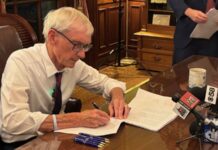While the COVID-19 pandemic disrupted and slowed certain research efforts in the state, it also gave researchers a chance to apply their work in new ways.
“The pandemic just really catalyzed this big push to move something forward,” said Sandra McLellan, a professor in the School of Freshwater Sciences at UW-Milwaukee. She spoke yesterday during a virtual WisBusiness.com luncheon event focused on federally funded research.
Early on in the pandemic, environmental microbiologists in the state working with wastewater and untreated sewage came together to develop a new method for COVID-19 community surveillance. McLellan explained that this effort “really was much more difficult than if we were doing it in a normally functioning lab,” as pandemic restrictions limited the number of scientists that could work in the lab and meet in person.
Still, by expanding on existing national collaborations with other scientists, she said the research team was able to create a “surveillance method that just wasn’t even in existence” beforehand. Her team, along with the Wisconsin State Laboratory of Hygiene, is currently monitoring 50 cities in the state. They’ve been able to identify outbreaks before they show up in testing results by tracking the levels of the virus in cities’ wastewater systems.
“Doing wastewater surveillance might be a way to track communities and see if there’s a warning flag that, ok, now we’ve got to jump back in with more public health measures or start testing again,” she said. “Over the last year and a half, I think we really have a good proof of concept for a way to do surveillance for this virus.”
Jeanne Hossenlopp, Marquette University’s vice president for research and innovation, said clinical research with human involvement has been “slower to come back” than certain basic science efforts due to the challenges of interacting with the public amid the pandemic.
“We phased back up, brought people in, but it’s not like flipping a light switch on,” Hossenlopp said. “You don’t just pick up where you left off … we are still pretty much in, for many of our research community, a recovery phase.”
But while COVID-19 has thrown a wrench into many research efforts, Medical College of Wisconsin researcher Dr. Shekar N. Kurpad said innovations in remote work technologies have actually improved lines of communication with colleagues and partners.
“Because of the parameters that the pandemic put upon how we functioned, we found new and different ways to collaborate,” he said. “Sometimes making a lot of collaborations, conversations, much easier than they used to be.”
When the pandemic first hit, UW-Madison medical student and researcher Katarina Marie Braun said she “happened to be at the right place and the right time” to accelerate her work, as she had been studying variations of bird flu.
“So it was really easy for my lab and me in particular to transition right over to COVID-19 and kind of jump right in, so my work certainly sped up,” she said. “I don’t think I left the lab for like a year.”
Both McLellan and Braun highlighted the importance of the collaborations they developed through their pandemic-inspired research efforts, as well as the value of keeping those partnerships in place going forward. Braun said “there wasn’t really infrastructure or support” for quickly transitioning research insights into public health implementation before the pandemic.
“What I worry is that without specific support, federal dollars to support those collaborations and to ensure that we’re prepared for the next pandemic, that those collaborations will fall away again,” she said.
All of the panelists highlighted the importance of federal funding on their work, particularly in the area of basic research where impacts might not be felt for a decade or more. Kurpad noted that federal support helps to “fuel the spirit for inquiry” by allowing researchers to focus on the big scientific questions rather than issues of funding.
“It gives them a certain span of time where they’re free to think, it’s a path to spawn off parallel thought processes in the people they have working for them, or themselves even,” he said. “That leads to more federal grants, more opportunities.”
Watch a video of the discussion here: https://www.youtube.com/watch?v=HHLmoQSd8-0
–By Alex Moe






